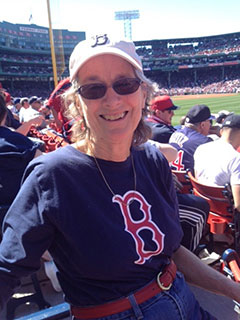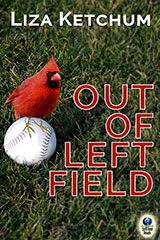 April 15 at Fenway Park was a bittersweet day, my first game after a brutal winter. On that beautiful, warm afternoon, bright colors dominated the ballpark. The players shagged balls under a turquoise sky, their uniforms a crisp white as they threw long, easy tosses across the outfield, into the infield, and back again.
April 15 at Fenway Park was a bittersweet day, my first game after a brutal winter. On that beautiful, warm afternoon, bright colors dominated the ballpark. The players shagged balls under a turquoise sky, their uniforms a crisp white as they threw long, easy tosses across the outfield, into the infield, and back again.
After endless blizzards that buried our cars and left us with eight-foot snow banks, the emerald grass looked smooth as velvet. And every player, from the Sox to the visiting Nationals, boasted the same scarlet number stitched onto his uniform: 42.
April 15 is Jackie Robinson Day, when Major League Baseball honors the first African-American to break the color barrier. In an act of courage that still gives me goosebumps, Robinson joined the Brooklyn Dodgers in 1947. I assumed, incorrectly, that everyone knew this history.
 On a recent middle school visit to discuss my novel, Out of Left Field, I described the autographed Jackie Robinson baseball card and its essential role in the story—and then noticed the blank stares on the faces of many students, including a few African-Americans. Then a white boy in the corner, who had ignored my presentation so far, suddenly announced, “Forty-two.” I gave him a thumbs up. He knew the significance of Robinson’s retired number.
On a recent middle school visit to discuss my novel, Out of Left Field, I described the autographed Jackie Robinson baseball card and its essential role in the story—and then noticed the blank stares on the faces of many students, including a few African-Americans. Then a white boy in the corner, who had ignored my presentation so far, suddenly announced, “Forty-two.” I gave him a thumbs up. He knew the significance of Robinson’s retired number.
In Boston, Jackie Robinson Day has been a time to celebrate. For some of us, it’s also an uncomfortable reminder of the team’s shameful history. The Red Sox didn’t field an African-American player until Pumpsie Green’s debut in 1959, a dozen years after Robinson’s Brooklyn arrival. Boston was the last team in the majors to break the color barrier.
Now April 15 also carries the weight of the Marathon bombings, and the Sox/Nationals game took place on the second anniversary of that traumatic event. For months, the bomber’s trial has dominated the news, forcing the bombing victims—as well as the rest of the region—to relive the horror. Boston’s Mayor Walsh had asked that One Boston Day become a day of remembrance, service, and random acts of kindness. He also requested a moment of silence at 2:49, when the first bomb exploded.
So I trudged up the ramp with a mix of emotions: pride, sorrow, excitement for the game ahead, regret for the past. I arrived in time to hear and see survivors of the bombings perform “The Star Spangled Banner” with courage and conviction. Flags snapped at half-staff in the breeze. We stood with hats off and hands on hearts, in awe of these survivors who still struggle with the wrenching, long-term effects of the violence.
I reached my seat in time for the first pitch. We didn’t play well, but I’m not sure it mattered. The clock ticked forward with the innings. Just after 2:45, the grounds crew ran out to sweep the base paths. At 2:48 the announcer asked us to stand.
I’ve been at Fenway many times when all the fans rise, but it’s usually a roaring ovation that celebrates a home run, cheers a pitcher’s stellar outing, or encourages a batter with the bases loaded. Sometimes fans jump up in anger, to boo an ump’s bad call.
This was different. 37,000 fans rose in quiet solidarity, hats off. We stood in silent unity, in respect for the city’s grief, determination, and resilience. Because it was an afternoon game, there were many kids in the stands, but they were quiet too. And we knew that, beyond the Green Monster, past the giant Coke bottle and the fancy box seats, the city was silent with us.
The Sox lost the game, 10-5, but that’s not what I’ll remember. Instead, I’ll think about the resolute strength of the survivors and their healers. I’ll think about Jack, my friend and seatmate, who could cite the background, stats, strengths and weaknesses of most players and was generous in answering my questions. I’ll remember Hanley Ramirez, hitting his first home run in a Red Sox uniform, the roar of the crowd as he rounded the bases.
Most of all, I’ll think about the little boy who sat a few rows ahead of us. Maybe five years old, he was dressed in a Sox uniform from head to toe, his eyes wide and eager. He was in the moment, living for each pitch, for the taste of his Fenway frank, the smell of cotton candy, for the joyous singing and pumping fists of “Sweet Caroline.” He shivered when the crack of a bat signaled a hit. That’s when he raised his mitt, every time—just in case a foul ball blistered past the Pesky Pole and into his waiting glove.
These were the feelings I hoped to capture when I wrote my novel: a child’s hope for the future, his belief in the dream. In the end, that’s what the game was about.
![The view from atop Fenway's Green Monster is great. The view from WITHIN? The on-field scoreboard operators get that rare perspective every game. By InSapphoWeTrust from Los Angeles, California, USA [CC BY-SA 2.0 (http://creativecommons.org/licenses/by-sa/2.0)], via Wikimedia Commons](https://www.lizaketchum.org/blog/wp-content/uploads/2015/05/Fenway_Park_View_from_Green_Monster_7186364942.jpg)

![In 2011, a fan got a peek inside Fenway Park's famed manual scoreboard. By C.S. Imming (Own work) [CC BY-SA 3.0 (http://creativecommons.org/licenses/by-sa/3.0)], via Wikimedia Commons](https://www.lizaketchum.org/blog/wp-content/uploads/2015/05/Checking_out_the_manual_scoreboard_in_the_belly_of_the_Monster.jpg)
![During the 2008 season, Wally tried to persuade Fenway fans to recycle. By malo (Own work) [CC BY-SA 3.0 (http://creativecommons.org/licenses/by-sa/3.0) or GFDL (http://www.gnu.org/copyleft/fdl.html)], via Wikimedia Commons](https://www.lizaketchum.org/blog/wp-content/uploads/2015/05/256px-Wally_the_green_monster.jpg)
![Pumpsie Green's role in Red Sox history is examined by Howard Bryant. By Derek Green (PUMPSIE GREEN AND D. GREEN) [CC BY 2.0 (http://creativecommons.org/licenses/by/2.0)], via Wikimedia Commons](https://www.lizaketchum.org/blog/wp-content/uploads/2015/05/Pumpsie_Green_2012.jpg)
 In Out of Left Field, Brandon treasures his souvenir Red Sox cap.
In Out of Left Field, Brandon treasures his souvenir Red Sox cap.

 Happy Earth Day!
Happy Earth Day!![The 2004 trophy didn't seem guaranteed after that season's opener. By User M@ on en.wikipedia (From en.wikipedia; description page is (was) here) [GFDL (www.gnu.org/copyleft/fdl.html) or CC-BY-SA-3.0 (http://creativecommons.org/licenses/by-sa/3.0/)], via Wikimedia Commons](https://www.lizaketchum.org/blog/wp-content/uploads/2015/04/256px-2004_WorldSeries_Trophy.jpg)
 Brandon
Brandon